Switzerland: The Alpine Pass Route 2003
 Monday, March 23, 2015 at 04:23PM
Monday, March 23, 2015 at 04:23PM After Morocco we badly needed some fresh, clean Alpine air to reignite our enthusiasm for hiking. Where better to find a supply of that than Switzerland? We signed up for a hike that would take us across seven high passes in the Bernese Oberland, from Meiringen to Saanen.
Our first impressions were all good, beginning with the fact that all of our luggage arrived with us in Zurich. From the airport we were to take an intercity train to Lucerne; the train station was inside the airport (how Swiss). We did have to negotiate a couple of escalators to get to it, but Swiss luggage trolleys are designed with this in mind; once they are pushed onto the escalator, they lock securely and automatically in place. This was new to Ellie, and she was not entirely persuaded by the technology. She fully expected her trolley to hurtle down the entire length of the escalator, taking her and a full complement of travelers and luggage carts with it, but of course it didn't (it was Swiss). Train times were clearly displayed at the station with track numbers and destinations, and we were soon on the upper deck of a train to Lucerne. There we changed to a cog railway, and were in the village of Engelberg at exactly 3:14 pm. Just as the (Swiss) timetable promised.
We attempted a few hours of sleep, and then went out in search of food and drink. A wrong turning led us into an impressive cloister, but with no beer in sight there we reversed direction, headed into the center of the town, and had our first, but by no means last, encounter with bratwurst and rösti (pan-fried potatoes), good Swiss beer and adequate Swiss wine. An unexpected rain shower sent us running (and puffing from the altitude) back to the hotel and bed.
We were to have a day in Engelberg on our own before meeting up with the rest of our group, and we planned to do a warm-up hike to compensate in a few hours for the conditioning we had failed to do over the preceding months. After a very ample breakfast in the hotel we made our way to the Ristis cable car, only to find operations temporarily suspended due to a lightning strike the night before. Cables had to be checked for damage, and this led to some speculation on our part as to how they really do that, and how thoroughly. Officials were studying various screens with what seemed like extreme seriousness, but was probably only Swiss efficiency. As we waited, increasing numbers of Swiss senior citizens arrived (the Swiss school summer holiday was just ending) to make the ascent, and since none of them seemed remotely concerned, we decided we should not be either. Once the cable car began running again we hopped aboard.
At the top of the lift we headed towards the Rugghugelhütte on what looked on the map to be a nice gentle walk. It was nice, and it was gentle in places, and almost totally deserted except for cows, but it was either much longer, or it took us much longer, than we had expected, and by the time we got to the Rugghugelhütte (6341 feet) we were struggling. With never a thought about our arteries, we ordered the rösti we felt we had earned, only this time we opted for the Alpenrösti, which came with egg, cheese and sausage. It was even better.
At the hotel that evening we met the rest of our group for an orientation. This being Switzerland, the logistics of the trip were quite straightforward. On every day except one we would carry only what we needed for that day; the rest of our luggage we were simply to leave at the hotel reception desk and it would magically travel, by train and/or bus, to meet us at our next destination. Which it always did, of course. And every day before setting out we would buy whatever we wanted for lunch.
By 9:30 am the next morning we were on our way to Engstlenalp. Our hotel was on the outskirts of the village, and the path we were to follow led directly up from behind the hotel - “up” being the operative word. It was a stiff climb on what is called a “transhumance” path, that is, one used to drive the cattle up to the higher alps. An alp, as the word is used in Switzerland, denotes a high, grassy, mountain pasture, and beginning in May the herds are led upwards, going ever higher as the snows melt, not to return to the valleys until October.
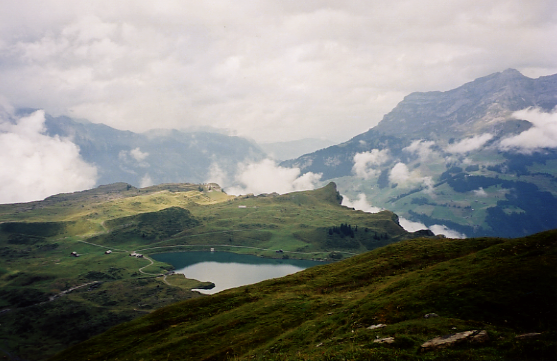 TrübseeWe reached the first of the two crests on our route that day and walked around Trübsee - a lake that was living up to its name - bleak, or dismal. After a summer of record temperatures, the weather had turned cold and wet, and we were only too happy to seek temporary shelter in a nearby restaurant. A flattish bit awaited us after that, but our path soon turned sharply upwards towards the Jochpass (7221 feet), where we were met by a short but serious downpour. From there it was all downhill - along the Engstlensee to Engstlenalp. Engstlenalp consists of one hotel, a few farm buildings, and a yogurt factory. The hotel was modern and spotless on the inside (hiking boots had to be left outside the front door), and dinner was delicious, as usual. We prefer not to divulge details of what we ate, conformity being the last refuge of the unimaginative. We took a brief walk around the barns and sheds afterwards to try to undo some of the damage, and rounded out the day with a few hands of cards.
TrübseeWe reached the first of the two crests on our route that day and walked around Trübsee - a lake that was living up to its name - bleak, or dismal. After a summer of record temperatures, the weather had turned cold and wet, and we were only too happy to seek temporary shelter in a nearby restaurant. A flattish bit awaited us after that, but our path soon turned sharply upwards towards the Jochpass (7221 feet), where we were met by a short but serious downpour. From there it was all downhill - along the Engstlensee to Engstlenalp. Engstlenalp consists of one hotel, a few farm buildings, and a yogurt factory. The hotel was modern and spotless on the inside (hiking boots had to be left outside the front door), and dinner was delicious, as usual. We prefer not to divulge details of what we ate, conformity being the last refuge of the unimaginative. We took a brief walk around the barns and sheds afterwards to try to undo some of the damage, and rounded out the day with a few hands of cards.
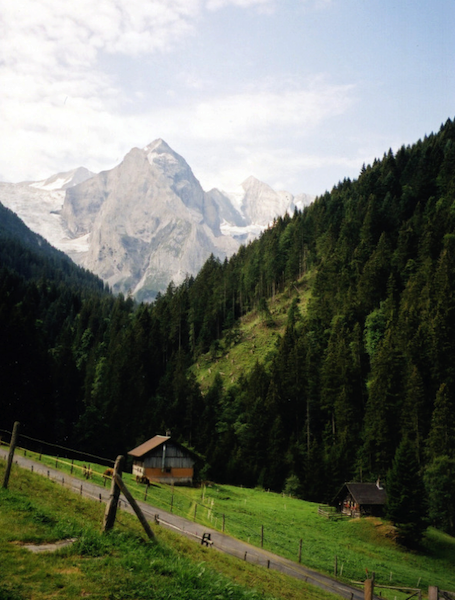 Between Meiringen and Grosse Scheidegg
Between Meiringen and Grosse Scheidegg
Breakfast was yogurt from the nearby factory, and it was superb. Then we set off, through pine and fir forests and always downhill, for the town of Meiringen. Meiringen is famous for meringues; they may or may not have originated there, and the name may or may not be derived from Meiringen, but the crafty Swiss saw a marketing opportunity and seized it. Meiringen also boasts a connection with Sherlock Holmes, and a fine statue of him commemorates that. On our way the next day we soon passed the Reichenbach Falls, where Sherlock Holmes and Professor Moriarty locked in mortal combat and met their doom. Soldiering up the Rosenlaue Valley, we made our way to Grosse (“great”) Scheidegg (6434 feet), one of the two passes that overlook the village of Grindelwald. The other is Kleine (“little”) Scheidegg and Kleine is inexplicably 200 feet higher than Grosse, which doesn't seem at all Swiss. It had been a long climb up from Meiringen, and the temptation of climbing aboard the Postbus to take us the 3000 feet down to the valley was too strong for us. Our knees were grateful, but our hearts were in our mouths as the fearless Swiss driver hurtled us towards Grindelwald at breakneck speed, one hairpin bend after another.
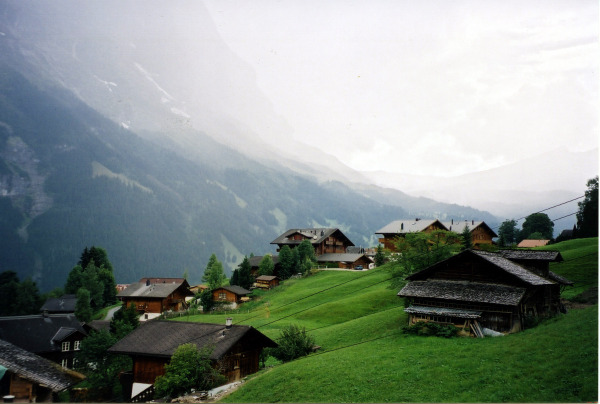 Approach to Grindelwald
Approach to Grindelwald
We were to stay two nights in Grindelwald, so one of us did the sensible thing – some laundry. The other trotted off to a nearby bar with two other tireless stalwarts and staggered back quite some time later, having had a hilarious time which she seemed determined to relate in every excruciating detail.
Suzy knew Grindelwald well from many visits there as a child. In the intervening half century both she and it had changed markedly. However, it still nestles amid some of the most recognizable and majestic mountains in Switzerland. One of them is the Eiger, the infamous North Wall (Nordwand) of which flanks the side of the valley, and remains an irresistible and often deadly lure to mountain climbers.
Despite a forecast of “changeable” weather, we decided to spend our free day going up to the Jungfraujoch, an unforgettable ride to the highest train station in Europe (11,333 feet). The Jungfrau (“maiden”) is the most westerly of a trio of mountains; the Eiger (“ogre”) the most easterly, with the Mönch (“monk”) placed strategically between the two to keep an eye on things. The Jungfrau is a much-photographed beauty, and as early as 1890 a Swiss engineer, Adolph Guyer-Zeller, came up with a workable design to drill a 10-foot high, 10-foot wide tunnel through 4¾ miles of limestone and gneiss, with gradients as steep as 1:4, to reach the saddle below the summit. The original plan called for continuing the tunnel almost to the summit of the Jungfrau itself (13,642 feet), which would then be reached by a 242 foot elevator, but that has been abandoned, at least for now.
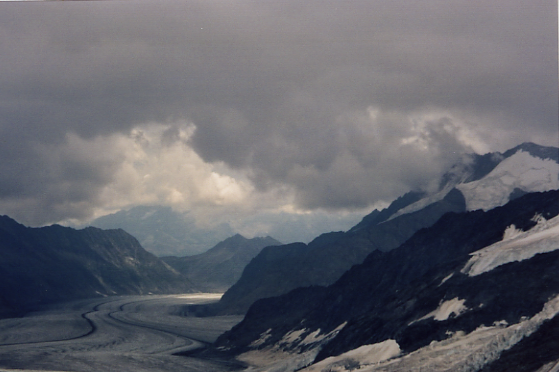 Aletschgletscher (Glacier) from Jungfraujoch
Aletschgletscher (Glacier) from Jungfraujoch
In 1912 the first passengers made the journey. We, like they, tumbled out of the train at the two intermediate stops of Eigerwand and Eismeer inside the mountain to marvel at the views. We lingered only briefly because it was cold at the first and colder still at the second, so when we arrived at the terminus at Jungfraujoch we were taken by surprise at how little oxygen there was up there, and how much we missed our accustomed supply. We had planned to do a one-hour walk from the Joch to a refuge, but rationalizing that the visibility was too poor, settled instead for staying close to the station and its attractions. These include Bollywood and sushi restaurants (testaments to tourists from around the world), and one can even buy Swiss chocolate made on site. One wonders at the marketing strategy behind that idea, but it must sell; the practical Swiss wouldn’t be doing it if it didn’t. There is an Ice Palace with rooms and sculptures, and an elevator up to the Sphinx – the highest viewpoint. We spent a few minutes watching those determined types who will settle for nothing less than the Total Experience: skiing, snowboarding, luging, abseiling, and being towed around a circuit by teams of huskies. And then we were more than ready to catch the train back down to thicker oxygen. That night we ate in a decidedly up-market hotel, and were able to treat ourselves to non-Swiss wine. Those crafty Swiss, nothing if not practical, having realized that their own generally mediocre wines wouldn't stand a chance when up against French or Italian competitors, simply slap taxes on all foreign wines that are so exorbitant that most medium-priced hotels and restaurants don't even bother to offer them. (Or perhaps their proprietors are just super-patriots, but we suspect the former.)
Back in our hiking boots the next morning, we took a cog railway part of the way up to Kleine Scheidegg. It was to be a long walk that day to Lauterbrunnen, and our guide felt that we wouldn’t miss much by giving ourselves a bit of mechanical help. At Scheidegg we stopped for lunch, and bravely decided to try to introduce some variety into our diet by ordering the...wurst and rösti! Then, always under the watchful eyes of the Jungfrau, Mönch and Eiger, we made our way down to Wengen, one of the two car-free villages perched on either side of the steep and consummately photogenic Lauterbrunnen valley. In Wengen a developing ankle blister justified our hopping on a train to make the final 1,657 foot descent to the valley floor, where we were to spend the night.
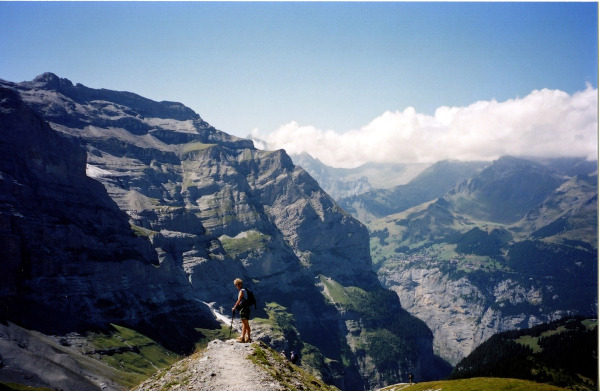 Between Eigergletscher and Wengen
Between Eigergletscher and Wengen
We were to have another rest day in Lauterbrunnen, and we craftily decided to walk a section of the following day's hike so that we could board the train along the same stretch the next day and still be able to say we had walked the entire distance from Lauterbrunnen to Kiental, simply doing it in a leisurely two days instead of the grueling one. (Such tweaking of the narrative is acceptable at our age.) The car-free village of Mürren is, if anything, even prettier than its counterpart, Wengen, on the other side of the valley: traditional chalets, profusions of flowers, perfect weather, and utter serenity. Had we not been the driven individuals that we are we could happily have gone quietly AWOL from the group and spent two weeks there. Twenty years down the road we may still do that.
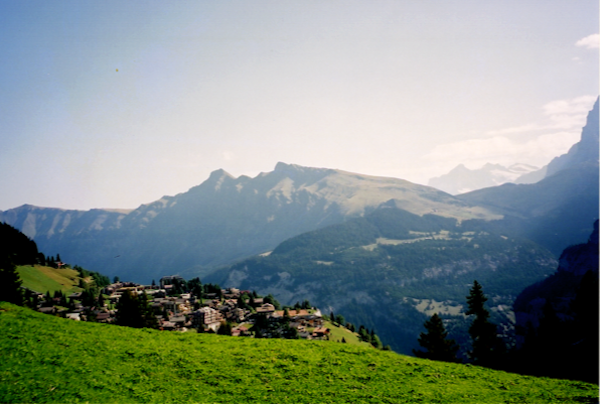 Mürren
Mürren
What we did do on that day was take the Schilthorn cable car up to Piz Gloria. It's a spectacular trip, even by Swiss standards. The cable is literally hooked to one peak at Birg, where one transfers into another car to be suspended over a deep valley and deposited onto a still higher peak, the Piz Gloria (9653 feet). Taking full advantage of the 360° views from the top is a revolving restaurant serving Swiss food; what more could one want? It is possible to walk back down to Mürren on a path that leads away from the top station at such a steep pitch that some people get right back on the cable car as soon as they see it.
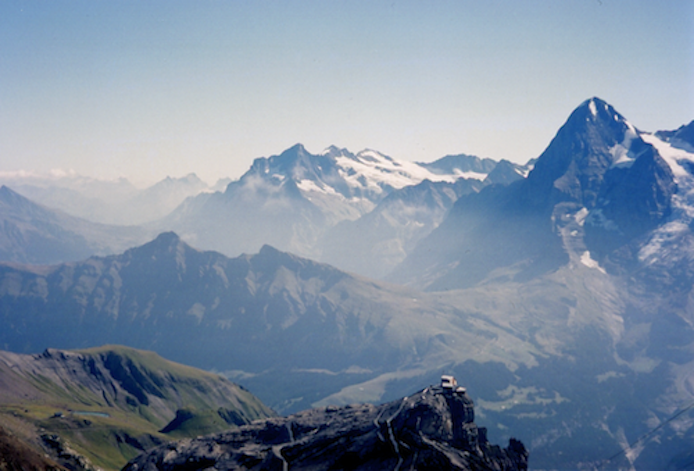 View from Schilthorn showing Birg Cable Car Station, lower right foreground
View from Schilthorn showing Birg Cable Car Station, lower right foreground
The same path, of course, is a ski run in winter; one can only hope the skiers carry good accidental death insurance. Our excuse for not walking down, and we're sticking to this, was the aforementioned blister. Once back in Mürren Suzy saw a “40% Off” sign outside a sporting goods shop and emerged with a fine pair of walking shoes. Wearing a boot on her good foot and a shoe on the other, she afforded numerous small Swiss children moments of merriment as they pointed out her odd footwear to their parents.
We were wise to have put a bit of the next day's hike behind us. Not only was it to be long and challenging, but our destination of Kiental was too remote for bus or train, so we had to carry on our backs everything we needed for the next two days. The route went up and over Sefinenfurgge, a 8,569 feet pass that is steep, cold and windy. The descent is so precipitous that wooden stairs had been installed for the first few hundred feet, and these we picked our way gingerly down. Where the stairs ended, an endless expanse of scree began. There was one small hut on the way where drinks could be had and a very rudimentary outdoor toilet visited, but it did have one attraction: a Swiss woman who said she came to stay at the hut whenever she could just because it was so isolated. With a tiny bit of urging we got her to break into some glorious yodelling. As we continued down towards Kiental we passed a man blowing an Alpenhorn. It was beginning to feel authentically Swiss, as opposed to touristy!
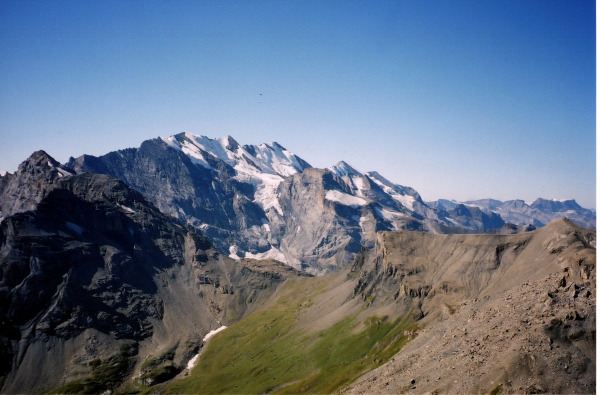 View of Sefinenfurgge Pass, from Schilthorn
View of Sefinenfurgge Pass, from Schilthorn
Our foremost memory of Kiental is the fact that a cheese festival had taken place there the day before. Cheese, ergo cows, ergo flies. And pitchers of water that we guzzled down freely, unaware until the bill arrived that a recent drought in the area justified the hotel slapping on a charge of $5 per pitcher.
Between Kiental and Kandersteg loomed the Hohtürlil Pass (9,028 feet), which put the Sefinenfurgge to shame. It took four hours of hard climbing to reach the top of the pass, and some sadistic Swiss had come up with the idea of locating the one and only hut several hundred feet above the top of the pass, so just when you thought you had arrived, and your thighs and knees were screaming for mercy, you realized that the sustenance without which you could not continue was another half hour away. That may not seem like much to those reading this on level ground at sea level. To them we say, you try it.
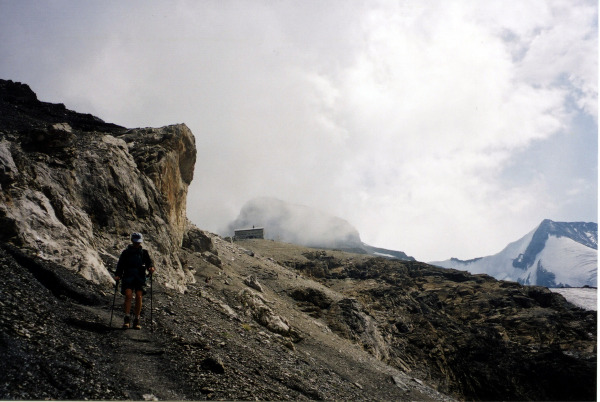 Descent from Hohtürlil to Kandersteg
Descent from Hohtürlil to Kandersteg
The descent was if anything even harder. The weather deteriorated and virtually obliterated our view of Oeschinensee on the way down, one of the lovelier lakes in the Alps, we were told. Kandersteg, however, was charming and our hotel very comfortable. After dinner we broke out some playing cards and persuaded another couple to join us. There was some initial hesitation on his part (his wife explaining that he hated to lose at anything and the game was new to him), but he caught on quickly and well. It was immediately evident that any fear of his losing was groundless, which would have been annoying had he not been such pleasant company away from the card table.
Just when Suzy thought she had her blister problem solved, she was walking merrily along the gently sloping road out of Kandersteg the next morning when the lace of one boot caught on the grommet of the other boot, unexpectedly hog-tying her. Both her hands were behind her back at the crucial moment, taking some of the weight of her backpack off her shoulders but unavailable to do anything to help break her fall, so down she went, face first, all 120 pounds of her and 30 pounds of backpack coming to rest on her chin. Our reluctant card player of the night before to the rescue! He and his wife were doctors, and because we had been so kind in allowing him to win at cards (as if we hadn't tried every way we could to prevent it) he and she returned the favor, establishing a termporary emergency room right there on the mountain, and arriving at our bedroom door every morning before breakfast from then on to check on the patient and redress the wound.
After that delay we struggled up towards the Bunderchrinde Pass (7,824 feet), from which we could see Adelboden, our next stop. That's always good, psychologically, but as is often the case, the villages are not situated at the very bottom of a valley, where there might be seasonal flooding issues, but a little way above. And that little way can seem like an Everest at the end of a hard day's hike. In the face of no alternative, one grits one's teeth, puts one foot in front of the other, and tries to hum one of the many songs that have been written about that last mile.
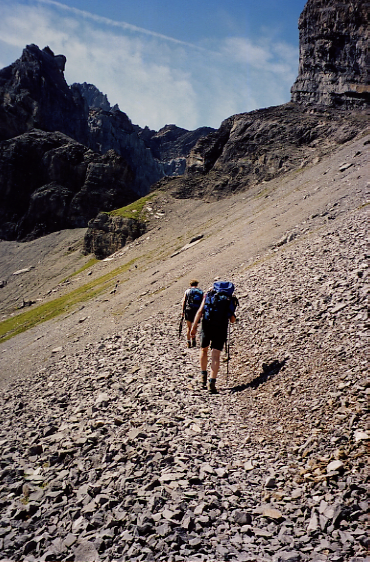 Bunderchrinde Pass
Bunderchrinde Pass
Awaiting us was another lovely hotel. There was a gathering of some kind going on in it which included an unending musical component; at first it sounded like just the kind of music you would want to hear in a Swiss village, and after fifteen minutes or so it made you want to switch hotels. Or perhaps we were just getting rotten cards that night and took it out on the entertainment.
After the physicians had made their rounds the next morning we set out for Hahnenmoos Pass (6,417 feet). It was an easy climb up and descent down through woods and meadows to Lenk. For several days now we had been casting around for some way to repay the doctor, and we had it on good advice that he would very much like to own a genuine Swiss cowbell. Not some souvenir with a Swiss flag painted on it, but the real article. We had tried to talk a cowherder we had passed into selling us one right off the neck of one of his animals, but he seemed more bewildered by the request than interested in our offer. Lenk, the least touristy of all the villages we had stopped in and surrounded by herds of cows, seemed like it might have the answer for us. One could safely assume that cowbells are as much a staple of Swiss life in a village like Lenk as, say, bread. Inquiries were made, directions given, and a shop found. Cowbells of every size and to suit every taste were neatly displayed in the window. And a “Closed Until August 31” sign was firmly affixed to the door. We had to settle for allowing (!) the doctor to beat us a few more times in our card games that evening.
We awoke to very poor weather and worse visibility. What to do? Most of our group showed a marked inability to adapt to changing circumstances and stuck adamantly to the planned program, which was to walk to St. Moritz and on to Saanen, our final destination.
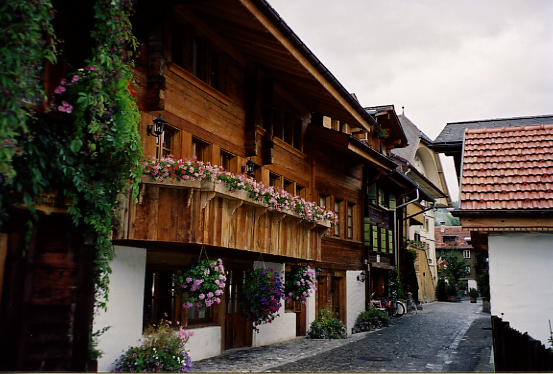 Saanen
Saanen
We, being of more flexible nature, took a look at the sky and jumped aboard a train to St. Moritz. We used the extra time there to drink coffee and size up that world-famous resort. Conclusion: It is neither particularly quaint nor picturesque, but does seem to have more than its share of short, balding, older men with tall, blonde, younger women. All beautifully and exotically dressed.
By early afternoon we’d seen enough of St. Moritz to know that it wasn't meant for us and vice versa, so found the route to Saanen and set off in what was still a steady downpour, following the river and the traintracks. Saanen is tiny, and our hotel there was functional, if somnolent. A large dog manned the reception desk and it took us some time to bypass him in favor of someone who could actually hand over a room key. It took even more time to explain that we were part of a group, the other members of which had yet to arrive. And finally, was there a refrigerator where we could store some food until the morning? “Ja, ja! Kommen Sie!” We dutifully followed, up a flight of stairs, through the kitchen and into the back where there was an enormous refrigerated storage unit, into which we deposited our little bundles. We were told three or four times exactly whom to ask for in the morning, in case the good fräulein didn’t happen to be around when we wanted them, and we halfway expected never to see them again, but this was Switzerland. Of course we saw them again.
We had a final farewell dinner, complete with quiz to determine which of us had retained the most in the way of names of mountains, villages and passes, altitudes, etc., and a small prize was presented to the winner. (Modesty dictates that she - or he - not be named.) The next morning we said our fond farewells to our companions at Saanen's little train station, and to our hiking boots, now safely stowed in our luggage, and headed to Geneva, where we planned to spend a night. The train station is conveniently right at the airport, of course, but since we weren't flying out until the next day and didn't think we could check ourselves or our luggage in yet, we were overjoyed to see a left luggage counter. In a rare instance of good planning we had packed a few overnight things separately in the hopes that we wouldn't have to haul our duffels to the hotel. It was with huge relief that we dumped them, forking over quite a few Swiss francs for the privilege. We then made our way to the ticket counter to confirm our seats for the next day (there had been some confusion about this at Dulles when we left, and we were still technically unconfirmed), only to have the super-friendly agent (a) assure us our tickets were in order, and (b) ask whether we had any luggage we would like to check in right there and then. Oops! We asked her to wait while we raced back to the left luggage counter to try to retrieve our duffels and our francs, only to come face-to-face there with the hard financial heart of Switzerland. The money had already been entered into the system, and it could not come back out. Duffels, however, could and did. Our friendly ticket agent relieved us of them, and unencumbered we hopped on the bus to our hotel. It had been billed on the Internet as an “airport” hotel, but they must have been referring to a different airport. It took forever to get to it, and forever again to get from it to the city center. I.e, the worst of all worlds, and something to bear in mind when making hotel reservations. Still, the breakfast was excellent.
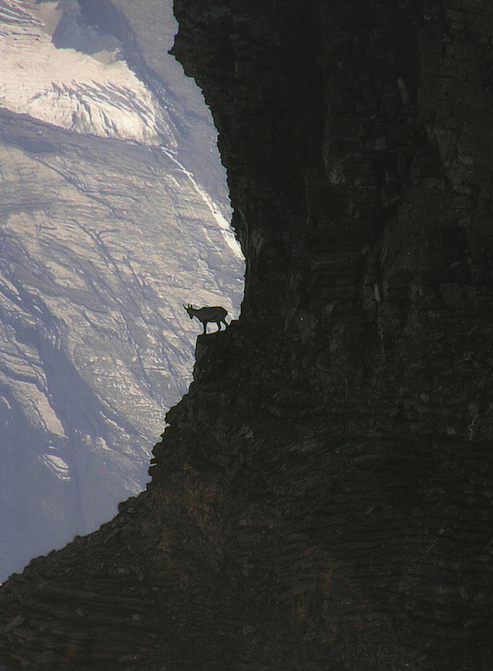 Chamois on Ledge
Chamois on Ledge
What to say about Switzerland? It probably won't offer “adventure” because everything will work like clockwork - predictably and punctually. The country delivers; what you expect to get you most likely will get, and if what you are looking for includes some of the best scenery on the planet, excellent food, well-established trails and user-friendliness wherever you turn, go to Switzerland. We certainly intend to return once we've checked off a few more of the destinations still on our bucket list.
click here to see a gallery of the photos

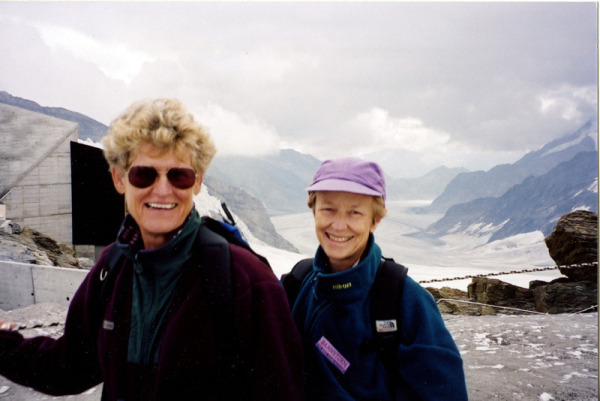
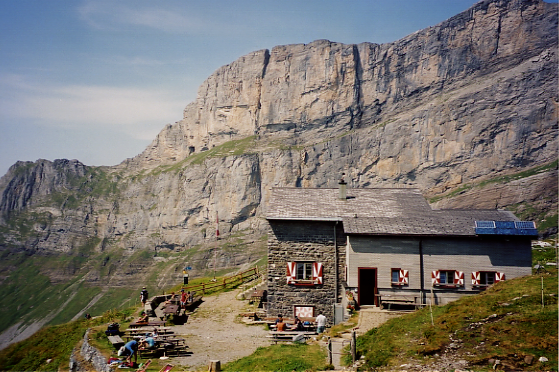
Reader Comments